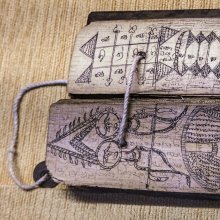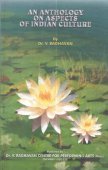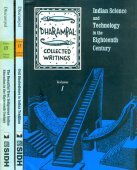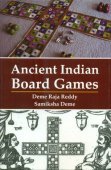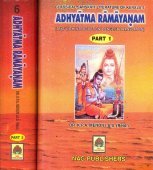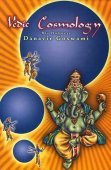Writing: 3 definitions
Introduction:
Writing means something in Hinduism, Sanskrit, the history of ancient India. If you want to know the exact meaning, history, etymology or English translation of this term then check out the descriptions on this page. Add your comment or reference to a book if you want to contribute to this summary article.
Images (photo gallery)
(+3 more images available)
In Hinduism
Purana and Itihasa (epic history)
Source: Shodhganga: Elements of Art and Architecture in the Trtiyakhanda of the VisnudharmottarapuranaWriting and Understanding (of code words and words in particular way), as part of the “sixty four kinds of Art”, according to the Kamasutra of Vatsyayana.—Cf the Sanskrit Akṣaramuṣṭikākathana.—Indian tradition, basically includes sixty four Art forms are acknowledged. The history of Indian Art covers approximately five thousand years which presents a rich and almost continuous record. The references of sixty four kinds of Kala (कला, kalā) are found in the Bhagavatapurana, Shaiva-Tantras, Kamasutra of Vatsyayana etc.

The Purana (पुराण, purāṇas) refers to Sanskrit literature preserving ancient India’s vast cultural history, including historical legends, religious ceremonies, various arts and sciences. The eighteen mahapuranas total over 400,000 shlokas (metrical couplets) and date to at least several centuries BCE.
Natyashastra (theatrics and dramaturgy)
Source: Shodhganga: Elements of Art and Architecture in the Trtiyakhanda of the Visnudharmottarapurana (natya)Writing (a letter) is associated with Tripatāka-hasta: one of the twenty-two Single-hand Gestures (in Indian Dramas) (known as asaṃyuktahastas), according to the Viṣṇudharmottarapurāṇa, an ancient Sanskrit text which (being encyclopedic in nature) deals with a variety of cultural topics such as arts, architecture, music, grammar and astronomy.—According to the Abhinayadarpaṇa, the tripatāka hand is used to denote some objects like crown, arrows, tree, the ketakī flower, lamp etc. This hand posture shows the action of writing letters. Indra along with his weapon i.e., vajra, is also shown with this hand posture in Dance.

Natyashastra (नाट्यशास्त्र, nāṭyaśāstra) refers to both the ancient Indian tradition (shastra) of performing arts, (natya—theatrics, drama, dance, music), as well as the name of a Sanskrit work dealing with these subjects. It also teaches the rules for composing Dramatic plays (nataka), construction and performance of Theater, and Poetic works (kavya).
India history and geography
Source: archive.org: Hindu Mathematics (History)Writing in ancient India.—The Hindus knew the art of writing in the fourth millennium B.C. They used numbers as large as 109 about 2,000 B.C., and since then their religion and their sciences have necessitated the use of large numbers. Buddha in the sixth century B.C. is stated to have given number names as large as 1053 and this number series was continued still further in later times. All these facts reveal a condition that would have been impossible unless arithmetic had attained a considerable degree of progress.

The history of India traces the identification of countries, villages, towns and other regions of India, as well as mythology, zoology, royal dynasties, rulers, tribes, local festivities and traditions and regional languages. Ancient India enjoyed religious freedom and encourages the path of Dharma, a concept common to Buddhism, Hinduism, and Jainism.
See also (Relevant definitions)
Ends with: Major writing.
Full-text (+1744): Lipi, Lekhana, Likhana, Lekha, Lekhaka, Alekhya, Lekhaniya, Likhita, Lekhani, Abhilekhana, Lekhya, Aksharasamsthana, Lipisajja, Aranyaka, Ullekhana, Bhurja, Upagrantha, Abhilikhita, Limpi, Guhalekha.
Relevant text
Search found 312 books and stories containing Writing; (plurals include: Writings). You can also click to the full overview containing English textual excerpts. Below are direct links for the most relevant articles:
Whither Telugu < [April – June, 1999]
How Good is the Indian Muse < [April – June, 2003]
Writing on The Wall < [October – December, 2000]
Harshacharita (socio-cultural Study) (by Mrs. Nandita Sarmah)
Part 4(b): Bāṇabhaṭṭa: His Style of Writing < [Chapter 1 - Introduction]
Part 2: Specialties and Divisions of Gadyakāvya < [Chapter 1 - Introduction]
Part 5: Cultivation of Knowledge < [Chapter 3 - Education System]
Tibet (Myth, Religion and History) (by Tsewang Gyalpo Arya)
7. The Scripts; dBu can and dBu med < [Chapter 5 - Tibetan Language and Writing System]
5. Zhangzhung Script < [Chapter 2 - Zhangzhung Civilization]
10. Conclusion < [Chapter 5 - Tibetan Language and Writing System]
The history of Andhra country (1000 AD - 1500 AD) (by Yashoda Devi)
The Literature of the Ancient Egyptians (by E.A. Wallis Budge)
Chapter I - Thoth, The Author Of Egyptian Literature
Chapter VI - The Egyptian Story Of The Creation
Srila Gurudeva (The Supreme Treasure) (by Swami Bhaktivedanta Madhava Maharaja)
The Story of Padmavati and Jayadeva < [Chapter 2.3 - I Must Do Bhajana]
Rāga-vartma-candrika < [Chapter 2.12 - Early ISKCON Conversations with Śrīla Gurudeva]
Related products
(+21 more products available)

